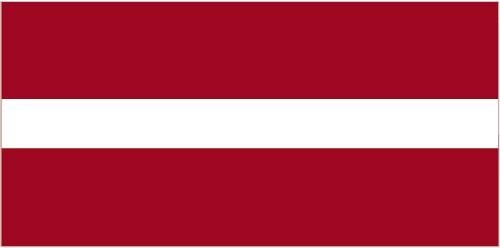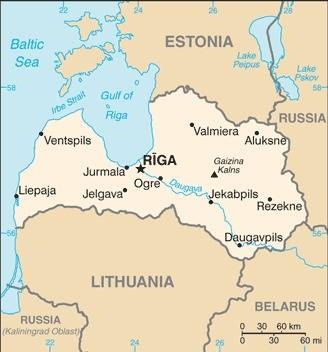87 Latvia

Three horizontal bands of maroon (top), white (half-width), and maroon. The flag is one of the older banners in the world. A medieval chronicle mentions a red standard with a white stripe being used by Latvian tribes in about 1280.
Flag courtesy of the CIA World Factbook

Map courtesy of the CIA World Factbook

The House of the Blackheads located in old town Riga was first built in the 14th century for the Brotherhood of the Blackheads Guild, a guild for unmarried German merchants in the city. The building was bombed by the Germans in 1941 and demolished by the Communists in 1948. Reconstruction took place between 1995 and 1999; the building currently serves as a museum and concert hall.
Photo courtesy of the CIA World Factbook
Government
According to Britannica, the Latvian constitution of 1922 provided for a republic with a president and a unicameral parliament, the Saeima. From 1940 to 1991 Latvia was a republic of the Soviet Union. On Aug. 21, 1991, the Latvian government declared independence, which the Soviet Union recognized shortly thereafter, and the 1922 constitution was restored. Latvia has a unitary form of government. The head of state is the president, who is elected by the Saiema for a four-year term (with a maximum of two consecutive terms) and who plays a largely ceremonial role. The government is headed by a prime minister, who appoints officials of the cabinet and is responsible to the Saiema. The Saiema consists of 100 members, who are elected to four-year terms.
Latvia is divided into 26 self-governed rajons (districts). Outside of this structure are seven major cities that are designated republican cities and have their own governments. The districts are further organized into pilsétas (towns), pagasts (rural municipalities), and novads (amalgamated towns and rural municipalities). Each of these local administrative units has its own governing body (a council elected by its citizens). Because the local administrative units are so numerous, many of them lack sufficient staffing and funds, and the Latvian government has attempted to consolidate the country’s administrative structure.
Latvia’s judicial system includes district courts, regional courts, and a Supreme Court. Supreme Court justices serve life terms, and judges in the lower courts serve two-year terms. The Constitutional Court of the Republic of Latvia was established in 1994 and began sittings in 1996. Its jurisdiction extends to areas such as ensuring the constitutionality of proposed legislation and of international agreements and ensuring that national laws are in compliance with international agreements. Justices of the constitutional court serve 10-year terms and are confirmed by the Saeima.
Latvian Civil Aviation Agency
The Latvian Civil Aviation Agency has been established to implement national civil aviation and flight safety policy in the Republic of the Latvia.
Airspace
SkyVector – Google Maps – ADS-B Exchange
ICAO countries publish an Aeronautical Information Publication (AIP). This document is divided into three parts: General (GEN), En Route (ENR) and Aerodromes (AD). ENR 1.4 details the types of airspace classes they chose to adopt from classes A through G.
Drone Regulations
Drone flights will be coordinated on a digital platform
LGS platform – the Electronic Unmanned Aircraft Restrictions Viewer (eUARV), which provides the aeronautical information necessary for the operation of unmanned aircraft.
Cabinet of Ministers Regulations No. 429
Advanced Air Mobility (AAM) Regulations & Policies
Bilateral agreements facilitate the reciprocal airworthiness certification of civil aeronautical products imported/exported between two signatory countries. A Bilateral Airworthiness Agreement (BAA) or Bilateral Aviation Safety Agreement (BASA) with Implementation Procedures for Airworthiness (IPA) provides for airworthiness technical cooperation between the FAA and its counterpart civil aviation authorities.
Reciprocal acceptance of aviation safety-related approvals and services with the European Union Aviation Safety Agency (EASA) and Member States of the European Union are primarily governed by the U.S. – European Union Safety Agreement.
Advanced Air Mobility (AAM) News
None found by the author.
However, should you, the reader, happen to stumble across something to the contrary, please email the author at FISHE5CA@erau.edu and you may be mentioned in the ACKNOWLEDGEMENTS section of this book by way of thanks for contributing to this free eBook!
Short Essay Questions
Scenario-Based Question
You have been hired by a Drone Startup Company. Your boss has immediately assigned this job to you.
They need you to prepare a one-page memo detailing the legalities of using a drone to film in Riga, pictured above.
They need you to mention any national laws and local ordinances.
They specifically want to know what airspace (insert pictures) you will be operating in and whether or not you need an airspace authorization.
Does it matter whether or not you are a citizen of the country?
Lastly, there is a bonus for you if, as you scroll through this chapter, you find any typos or broken links!
Short Essay Questions
- What are the drone categories?
- How is registration addressed?
- How is remote ID addressed?
- What are the model aircraft rules?
- What are the commercial drone rules?
- Are there waivers or exemptions to the rules? If so, for what?
- Would you share a link to an interactive airspace map?
- How is BVLOS addressed?
- How can you fly drones at night?
- How can you fly drones over people?
- Where do you find drone NOTAMs?
- What are the rules for drone maintenance?
- What are the rules for an SMS program?
- What are some unique rules not mentioned above?
- What are the C-UAS rules?
- What are the AAM rules?

